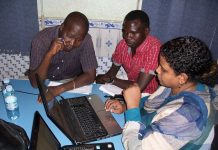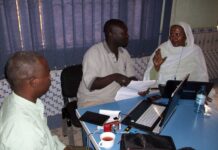
Launching a community radio station is a complicated exercise with lots of overlapping elements. The most important thing to do, before you do anything else, is to stop and think.
Every minute of careful thought before you take action will save hours of problems later. So plan your community radio station carefully, trying to anticipate all the work that will be required, how long it will take and in what order it should be carried out.
This involves separating the exercise into all its component parts and understanding how they relate to each other – in what project management specialists call ‘dependencies’.
Here is a suggested project plan that can be adapted to suit local circumstances. It has three main phases.
1: Concept phase
In this early stage you will try to answer four important questions:
- What is the editorial proposition? – What kind of radio station do we want this to be? What will be the main content elements? What will be the tone of the station? In what way, editorially, will we reflect and foster the spirit of the community?
- What is the target audience? – The obvious first response to this question is that a community radio station tries to reach the whole community. Yes, but that is unhelpful. What is the make-up of the community? How is it organised? What are people’s preoccupations and anxieties? What methods are available to find out what members of the community want?
- What is the funding model? – Community radio stations are usually owned and operated by the communities they serve and are run on a not-for-profit basis. They might receive grants from governments, philanthropic foundations, individuals or other sources. They might generate revenue from advertising or sponsorships. But whatever the funding model, the financial basis needs to be clearly understood and sustainable.
- What is the governance and management model? Who will carry financial responsibility? Who is responsible for setting the strategy? Who will run the station on a day-to-day basis?
2: Planning phase
- Finance: Funding, from whatever source(s) needs to be secured. A community radio station is not a commercial business but it needs to be run in a business-like manner. It needs a budget and a means of monitoring expenditure. It probably needs bank accounts and perhaps lines of credit. Who will take care of the financial operation?
- Distribution: How is the station to be broadcast? Will it have a conventional transmitter, in which case is there a requirement to obtain licences? Will it be Internet-based, in which case where will it be hosted? Investigate availability of free tools.
- Production: What technology is required? Will it be broadcast engineering-level or desktop software? Investigate availability of free tools. Draw up a Technical Requirements document (the TechReq).
- We have compiled a list of free tools for community radio that were available in May 2025 when this guide was written. You kind find the list at the foot of this page. Click here to jump to it. We suggest you do a web search to see if any new tools or updates have been released since this article was published.
- Accommodation: Does the station need premises or can it be done virtually? If premises are needed, what fixtures and fittings are necessary?
- Transport: Depending on the size of the community, some means of getting around might be required. Is it important to acquire vehicles for transport or outside broadcasts?
- Staff and volunteers: The purpose of the community station is to engage with the community. It is a people business. Staff and volunteers need to be recruited and trained. How many staff, with what existing skills (editorial, engineering, presenters etc) need to be hired? How many volunteers will be required and how will they be selected?
- Administration: What administrative support is needed (to take care of book-keeping, answering listeners’ queries, managing the premises etc)?
- Marketing/promotion/communications: How will the station make itself and its programming known to the audience?
- Legal and insurance: What professional advice and coverage are needed in these areas?
3: Implementation phase
After the thinking and planning comes the execution, culminating in the launch of the station. These are some of the actions:
- Premises: Hire/buy – furnish and equip
- Technology: Hire/buy – equip – test – maintain
- Staff and volunteers: Select – train – test – produce
- Programming: Create schedule – pilot – test – reiterate
- Marketing/promotion: Pre-launch publicity
Suggested community radio station project timeline
The timeline assumes a 12-month project duration. Adjust durations based on local circumstances, resources, and community size.
Concept phase (Months 1–3)
The concept phase focuses on defining the station’s vision, audience, funding, and governance. All tasks are foundational and must be completed before moving to the planning phase.

Milestone: Concept phase completed on time with a clear station vision and governance structure.
Planning phase (Months 4–8)
The planning phase involves securing resources, defining technical and operational needs, and preparing for execution. Tasks can overlap but depend on concept phase completion.
 Milestone: Planning phase completed on time with funding secured, technical plans finalised, and recruitment strategy ready.
Milestone: Planning phase completed on time with funding secured, technical plans finalised, and recruitment strategy ready.
Implementation phase (Months 9–12)
The implementation phase executes the plans, culminating in the station’s launch. Tasks are sequential or overlapping, with testing and iteration critical before launch.
 Milestone: Station launch on time.
Milestone: Station launch on time.
Notes
- Dependencies: Ensure tasks in each phase are completed before starting dependent tasks in the next phase. For example, funding must be secured before premises or technology procurement.
- Flexibility: Adjust durations based on community size, available resources, and regulatory requirements (e.g. licensing for transmitters).
- Overlap: Some tasks (e.g. marketing strategy and recruitment planning) can run concurrently to save time.
- Testing: Allocate sufficient time in the implementation phase for testing and refining technology and programming to avoid launch issues.
- Community engagement: Involve the community throughout, especially in the concept and implementation phases, to ensure the station reflects local needs.
This timeline provides a structured approach to launching a community radio station, balancing thorough planning with timely execution. Feel free to download and adapt to your own local needs.
Free tools for community radio
These were tools available online as of May 2025. We suggest you do a web search to check for updates or any new tools that have been released since.
For audio hosting and sharing:
- SoundCloud: https://soundcloud.com/
For audio editing and production:
- Audacity: https://www.audacityteam.org/download/ (Available for Windows, macOS, and Linux)
- Ocenaudio: https://www.ocenaudio.com/download (Available for Windows, macOS, and Linux)
- MyEdit: https://myedit.online/ (Web-based, no download needed for the online editor)
For radio automation and scheduling:
- RadioDJ: https://www.radiodj.ro/download (Windows only)
- PlayIt Live: https://www.playitsoftware.com/Products/Live/Download (Windows only)
- Mixxx: [suspicious link removed] (Available for Windows, macOS, and Linux)
For live streaming:
- BUTT (Broadcast Using This Tool): https://sourceforge.net/projects/butt/files/butt/ (Available for Windows, macOS, and Linux)
- OBS Studio: https://obsproject.com/download (Available for Windows, macOS, and Linux)
- LadioCast: (Primarily available through the macOS App Store, search for “LadioCast”)
For finding your station listeners:
- Radio Garden: http://radio.garden/ (Web-based)
- Streema: https://streema.com/ (Web-based)
- Online Radio Box: https://onlineradiobox.com/ (Web-based)
- RadioBrowser: https://www.radio-browser.info/ (Web-based with API access)
- Internet Radio: https://www.internet-radio.com/ (Web-based)








